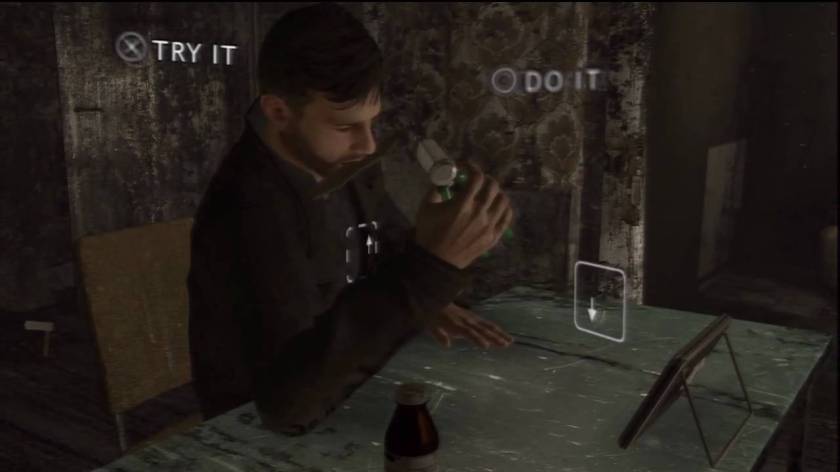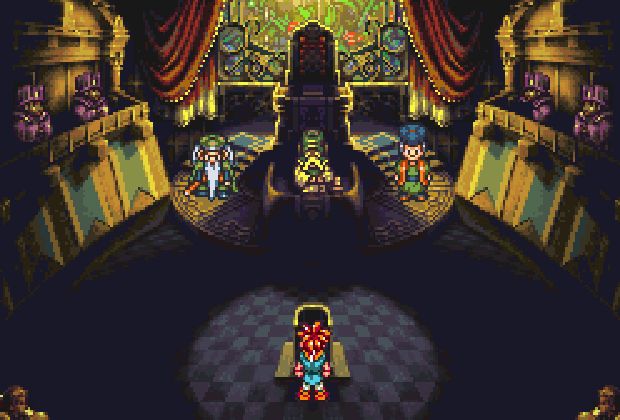Welcome to another edition everyone!
You may remember my post not so long ago on the differences between Choices, Decisions and Calculations which is available here. This week I’m looking at Choices VS Consequences and taking another approach to how we can use scenarios effectively in E-Learning development and Instructional Design.
There is a distinction that has to be made between these two options and if you are designing an E-Learning course thought should be given to which route should be followed. It is very difficult to design for both, it can be done, but if you’re starting out focus your attention on creating an immersive experience in your learning using one of these approaches.
I’ll be focusing on two games to help me illustrate how you can take advantage of these approaches, one of these is Heavy Rain, the other one is Chrono Trigger. As we’ll be only be looking at example pieces from these games I’ll keep their introductions short.
Heavy Rain
Heavy Rain is an interactive drama action-adventure video game developed by Quantic Dream and published by Sony Computer Entertainment exclusively for the PlayStation 3 in 2010.
The game is a film noir thriller, featuring four diverse protagonists involved with the mystery of the Origami Killer, a serial killer who uses extended periods of rainfall to drown his victims. The player interacts with the game by performing actions highlighted on screen related to motions on the controller, and in some cases, performing a series of quick time eventsduring fast-paced action sequences. The player’s decisions and actions during the game will affect the narrative. The main characters can be killed, and certain actions may lead to different scenes and endings.
Chrono Trigger
Chrono Trigger (Japanese: クロノ・トリガー Hepburn: Kurono Torigā) is a role-playing video game developed and published by Square (now Square Enix) for the Super Nintendo Entertainment System in 1995. Chrono Trigger ’s development team included three designers that Square dubbed the “Dream Team”: Hironobu Sakaguchi, the creator of Square’s Final Fantasy series; Yuji Horii, a freelance designer and creator of Enix’s popular Dragon Quest series; and Akira Toriyama, a freelance manga artist famed for his work with Dragon Quest and Dragon Ball. Kazuhiko Aoki produced the game,[6] Masato Kato wrote most of the plot, while composer Yasunori Mitsuda scored most of the game before falling ill and deferring the remaining tracks to Final Fantasy series composer Nobuo Uematsu. The game’s story follows a group of adventurers who travel through time to prevent a global catastrophe.
Designing with Choice
In Heavy Rain you reach a point where you are faced with a decision to cut off one of your fingers in return for information on where your son is being held – all very dark stuff. But this is a great example of a moral choice, you have multiple options available to you and those options all have an elements of the unknown. You can choose to go through with the ‘procedure’ (of course you have to do this yourself in a very disturbing body DIY project) or you can choose to say no. Whichever option you choose here you can make several assumptions about how they may affect your long term goals. There is a moral obligation to assist your son but the thought in the back of your mind that this may still not be enough to release the information you need – is it all just a sick joke?
Designing with Choice in E-Learning
The same should be thought of for E-Learning scenarios, they are developed so that they provoke the learner into making meaningful decisions that may affect their outcome. When we create situations like this it is imperative that the answers are well thought out – the learner (or player) must be in a position of unknowing. Of course it’s highly unlikely that a SME will ever want this sort of scenario in their course however we can extract some of the more powerful or moral standpoints. Just consider a course around the topic of Diversity & Inclusion for example, there are plenty of moral choices that can be crafted here. What’s particularly powerful about Heavy Rain is that even though you know you have a moral obligation to carry out the act, the option to say ‘No’ is still a viable choice. On the surface it should be a snap decision – when you’re playing it really isn’t.
So if we want to create moral choice in our courses we need to carefully assess the material we’re provided with and be active with the client to determine just how far we can push the content. A lot of thought needs to be given to your answers and you need to ensure that the learner (within reason) is contemplating each answer seriously. How many courses have you seen that have three obvious distractor answers and the correct answer is so clear that it may as well have been highlighted in red, underlined and put in bold. We simply cannot design scenarios in this way if we want them to be effective.
Designing with choice in mind is one effective approach to help bring gamification into your E-Learning course. There are easy options to help branch from slide to slide to reveal both positive and negative ramifications to decisions. You can then support these decisions with achievements and/or points – personally I like to create engagement from the content rather than supporting it with either of these. However they are both still viable options that have plenty of backing to support your gamification methods.
Designing with Consequences
What does that look like I hear you scream. Well to illustrate the way we can draw from how games portray consequences let’s look at Chrono Trigger. I’ll cover what these interactions are and then tie up the piece by illustrating how the consequences for the actions you take come to light.
You take control of your character in an area called Leene Square. Chrono Trigger allows you to interact with people in the square – depending on how you act with these NPCs (Non-Player Characters) depends on what happens to you in the following scenes. Now, there is an element of decision making involved here but the main dynamic occurs in the consequences phase of these actions.
The Interactions
One of the first interactions you’ll engage with is a girl running around the square, when you try to speak to her she will bump into you and fall over, losing her pendant at the same time. Now, there are two options here, do you talk to the girl again to see if she is ok? Or do you walk over an pick up her pendant?
The next interaction you face will see you talking to the owner of the equipment shop in the game. He will try and persuade the girl who you knocked over to sell her pendant to him. Do you encourage her to sell? Or do you tell her to keep the pendant?
As you walk around Leene Square you’ll see an old man with a bag of lunch next to him, you are completely free to take this bag off him, but do you?
Fourth interaction now and there is a young girl in the square who has lost her cat, do you help her to find the cat or do you decide that it isn’t a good use of your time?
Lastly the girl who you knocked down (she’s joined you if you wondered why she’s following us around) wants to stop and get some candy from the shop. Do you sit patiently for her to order her candy or do you get fed up and walk out? Whilst playing the game if you choose the first option you mustn’t touch the game pad at all whilst waiting otherwise you will automatically choose the less patient option.
So, they are the various interactions you’ll face as you casually explore the opening section of Chrono Trigger, it all seems very gentle doesn’t it? WELL that’s where our consequences come in to play and an opportunity to discuss a similar structure in E-Learning.
After these seemingly ‘innocent’ tasks have been accomplished the game progresses and nothing seems to come of it. Until a while later when you are arrested by the Chancellor for apparently kidnapping the young girl who joined you. You are the swiftly thrown into a court room where the interactions you engaged with previously are used against you. There will be witnesses at the trial, those witnesses are the people we met earlier. For example if you choose to steal the old man’s lunch he will testify against you in the court.
So what happened here is we were given a set of seemingly meaningless interactions, but actually they all play an ingenious part fitting back with the story. This is where we see the differences between developing E-Learning with choices or consequences in mind. Choices engages us by offering morally challenging options – consequences make us evaluate the causality of our path.
Consequences in E-Learning
What we need to consider when we think about consequences is ‘what are we really trying to reveal to the learner?’ This is incredibly important when considering your approach – we don’t simply want to crush their spirit, tell them they are wrong or take points from them (in fact this approach reduces engagement and is more likely to deter the learner) instead we need to consider the chain of causality. What made the learner to make that choice? The reason I’ve quoted Chrono Trigger is that the events you conduct in the beginning of the game feel as though they are done without a purpose, but seeing the consequences of our actions gives us links back therefore allowing the player to contemplate their actions. It offers a chance to reflect and say “Well, why did I still that old guy’s lunch? That was pretty stupid of me.”
Doesn’t this seem like a fantastic option for E-Learning? We know that grabbing learner engagement can be a difficult thing especially during the opening of a course. What about using a small warm up exercise that shows the learner that the decisions they make have consequences. This also fits straight in with a range of topics, we can design Health and Safety courses with consequences in mind and surprise people by showing them that overlooking small things can cause big accidents. The next time you are creating a course try to work backwards through the process, this will help you to understand the contributing factors to the ‘consequence.’
The possibilities of using consequences are almost endless. Whilst we do not have to design with strictly one of these options we need to be aware that they require a different focus. If we choose to go down a choice route for our course then we need to consider engaging, real and moral answers that can support the scenarios we create. If on the other hand we choose to design with consequences in mind we need to consider the causality of the answer we are given along with the outcome the learner receives. We shouldn’t make the outcome crushing for the learner we should instead illustrate how they got to this point and perhaps show them feedback on how they could have changed this. Of course we can then feed in many other game mechanics into our work including points for successfully navigating scenarios or avoiding the bad consequences to actions. If we start with a base of one of these options feeding from the inspiration that games can give to us we can dramatically improve the quality and the engagement rates with our E-Learning courses.





Thanks Joshua, for another great post. Do you think choices in gamification then rules out the 3 lives? And it’s better to explain where the learner has gone wrong,rather than to disengage them?
Chris
LikeLiked by 1 person
Hello Chris – I would definitely look at explaining to the learner where they have gone wrong. Depending on the content and especially during a ‘consequences’ based approach it’s important to support them through their choices as a lot of learning comes from that reflection piece. Of course this isn’t going to work in every situation and actually it’s only something I’d really looking at doing when dealing with consequences. Of course during a scenario based approach the ‘wrong’ answer is usually very clear to the learner without the need to prompt.
The great thing about gamification and taking some of these design principles from games is that they are very flexible. Depending on the project a whole range of solutions may fit.
Thanks again for the positive feedback Chris.
LikeLike
Joshua, great site thank you for sharing. You have provided me with plenty to consider as i don’t play video games and unaware of how much went in to their construction. Have signed up and look forward to some more learning about gamingintraining.
Jo
LikeLiked by 1 person
Hello Jo, not a problem at all!
That was the inspiration for the blog – it is to provide some background knowledge of video games but more importantly show everyone what we can learn from them.
I really appreciate the comment, thanks for posting!
LikeLike